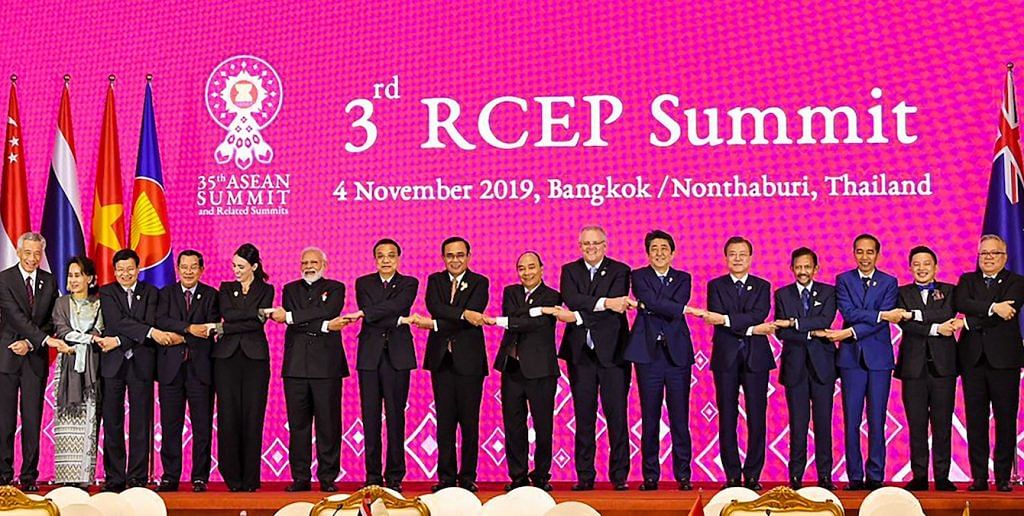PM Narendra Modi decided Monday that India will stay out of the 16-nation Regional Comprehensive Economic Partnership Agreement or RCEP, for now, after years of negotiations. The RCEP negotiations started in Cambodia’s capital Phnom Penh in November 2012. It looks to cover “goods, services, investments, economic and technical cooperation, competition and intellectual property rights”. Countries negotiating the RCEP hoped to reduce or completely remove all tariff and non-tariff barriers on imports and exports. Until last week, there was hope India would sign the agreement despite qualms on a number of issues. That was not to be. Knives are now out in mainstream and social media with analysts and journalists alike lambasting the Narendra Modi government for turning its back on a purportedly historic trade pact, which now apparently leaves uncertain India’s economic future.
But these largely arm-chair, knee-jerk and myopically self-serving commentaries misread the fundamental nature of trade agreements and trade negotiations — these rules are not bargains designed to reap certain long-term strategic gains, like balancing China or supporting the United States in fortifying its regional position (as in the case of the Trans-Pacific Partnership), which are incidental benefits, but domestic political agreements that rest on clear support from domestic interest groups who either back or stall new trade rules based on material considerations. Baseline matters.
Also read: India opts out of RCEP for now but to continue negotiating over differences
International trade agreements
The hues and cries of analysts elide one critical issue — negotiating positions on international trade agreements are a function of two factors. First, institutional awareness of India’s trade balance and how various industries are faring, and second, the vigour with which Indian firms, and other relevant interest groups, are clamouring for greater market access to seize extant opportunities. When both these factors are strong enough, India will be more inclined to support and sign trade agreements.
This was the case at the last major World Trade Organization (WTO) trade agreement — the Uruguay Round agreement — signed in the mid-1990s. Indian trade negotiators were astutely aware of India’s domestic trade scenario, which was on a reformist path and eager to secure new markets to generate more revenues; firms in these areas and business lobbies pushed Indian negotiators to be more pragmatic, secure access and necessary exemptions for fair competition. Indian negotiators used Uruguay Round negotiations to secure greater market access for Indian exports, primarily textiles, agriculture and services while conceding on intellectual property rights issues.
Also read: India will not join RCEP trade deal, my conscience won’t allow it, says PM Modi
Why India stayed out
Looking at the RCEP, we can find parallels but with one exception that likely influenced India’s decision to not join the pact. Institutionally, trade officials were aware of India’s shaky trade balance and competitiveness — and that, for various reasons, India has a trade deficit with most RCEP countries including several ASEAN countries, South Korea, China and Australia that runs north of $100 billion. Given the state of India’s internal competitiveness in several industries including dairy and manufacturing, firms in these sectors would have found it difficult to place commodities in Asian markets. Deteriorating export potentials do not lead to pleas for greater market access; if anything, firms in these industries would have compelled negotiators to remain steadfast from conceding greater access to the Indian market.
Potential losses from foreign goods, who would find more space in the Indian market, likely tipped the scale toward rejection. In its current form, the RCEP does not improve the material standing of Indian firms, particularly in areas like agriculture, electronics and manufacturing. India currently sends roughly 20 per cent of its exports to RCEP countries, while importing nearly 35 per cent in return.
India’s metal producers stand to lose from greater competition having already been buffeted by previous FTAs with Southeast Asian countries. In terms of agriculture, firms producing commodities like dairy, pepper, coconuts, and cardamom will face pressures from both higher-end producers like Australia and New Zealand and also like-minded competitors in ASEAN, which is the case for Indian rubber.
Alarmingly for New Delhi, China, an RCEP proponent given languishing trade ties with the United States, exports more to India than all other countries. If the ASEAN-China Free trade agreement (ACFTA) is an indicator, then India has a great deal to be reticent about in terms of the RCEP.
After the ACFTA, China’s trade in ASEAN increased around “5-6 times between 1995-2017” — or in other words, China’s share in ASEAN’s imports “saw a steep rise vis-à-vis exports” at the same time. That shows Chinese firms got far more access to ASEAN markets than the other way around.
With an RCEP, India could be the next ASEAN.
The doomsdayish commentary on India’s rejection belies a simple point — India’s desire to break a rule, in this case the RCEP, was a rational choice likely made after close consideration of facts on India’s current trade balance and whether the agreement would improve or degrade it. Evidence, more or less, suggests the latter.
Also read: RCEP deal will turn ‘Make in India’ to ‘Buy from China’: Rahul Gandhi targets Modi govt
The author is Research Fellow, Institute of South Asian Studies, National University of Singapore. Views are personal.
